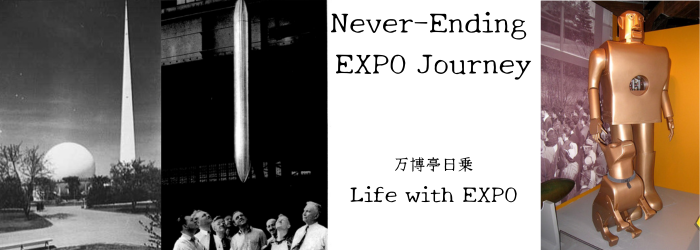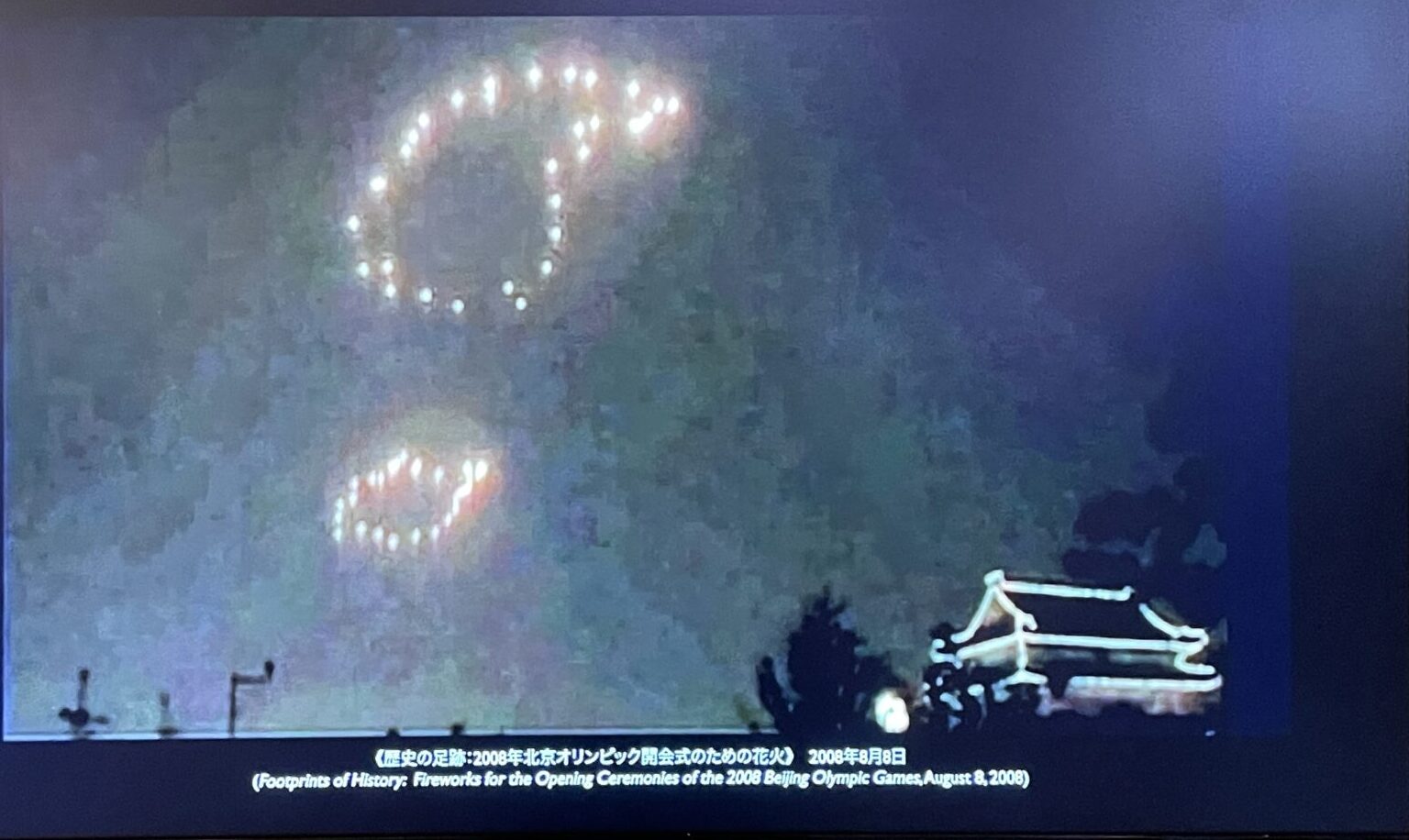Cai Guo-Qiang Exhibition at the National Art Center, Tokyo
The hot days continued this week, and it felt like the rainy season had already ended. I didn’t feel like walking around much.
However, as I heard that “Cai Guo-Qiang Ramble in the Cosmos – From Primeval Fireball Onward” is being held at the National Art Center, Tokyo in Roppongi, I thought I definitely have to go!, so I went to see with assistant No. 0.
The National Art Center, Tokyo was designed by Kurokawa Kisho (1934-2007).
It opened in January 2007.
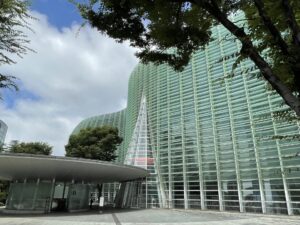
国立新美術館
The National Art Center, Tokyo
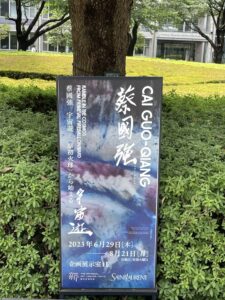
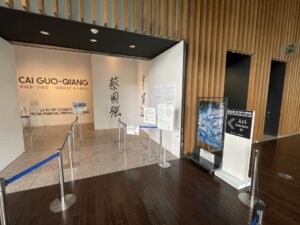
展覧会入り口
Entrance of the Exhibition
I touched on Kurokawa Kisho in episode <22>, ” Nakagin Capsule Tower and “Habitat 67”,
so please refer to it.
This time, Cai Guo-Qiang’s exhibition is being held at the museum designed by Kurokawa Kisho.
Date: June 29 (Thursday) – August 21, 2023 (Monday) (closed every Tuesday)
Organized by: The National Art Center, Tokyo, SAINT LAURENT
Cai Guo-Qiang (1957-) is an artist from Fujian Province, China, who is famous for his art using gunpowder explosions.
His famous performance examples include the fireworks art for the opening ceremony of the 2008 Beijing Olympics, and the performance at the Huangpu River in Shanghai for the closing event of 2001 APEC (Asia-Pacific Economic Cooperation) conference.
The former was televised worldwide on live television. Many readers may have seen it because it was the opening ceremony of the Olympics.
As for the latter, I think it was NHK, a Japanese TV station also had a special feature on it, and I remember watching that program.
I still remember how Cai Guo-Qiang happily shouted in Japanese, “It’s turned into a work of art!” many times while watching the large-scale fireworks performance she produced.
Cai Guo-Qiang was an artist who spent time in Japan from 1986 to 1995, and as introduced in detail in the fifth section of the exhibition this time, he lived in Iwaki City, Fukushima Prefecture, and has been interacting with the people of Iwaki City for a long time.
As mentioned above, this exhibition is being held at the National Art Center, Tokyo in Roppongi, and even though the author and assistant No. 0 went there at 10:00 a.m. on a weekday morning, there were many people coming to see the exhibition.
The exhibition is divided into five parts.
1. Pre-Primeval Fireball: What Gave Birth to the “Big Bang”?
2. “Big Bang”: Primeval Fireball : The Project for Projects, February 26-April 20, 1991
3. Post-Primeval Fireball
4. Is the Spirit of Primeval Fireball Still Alive?
5. Cai Guo-Qiang and Iwaki
What is the “Primeval Fireball “ used in the titles 1 to 4?
This is the word for “primordial fireball just before the big bang”, and was also the title of Cai Guo-Qiang’s solo exhibition held in Tokyo in 1991.
So, the works must be exhibited in the flow of – before the solo exhibition, the solo exhibition, and after the solo exhibition.
Composed of a diverse group of works, including arts using gunpowder, videos, photographs, and objects used in performances, you will be captivated.
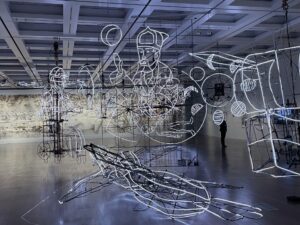
『未知との遭遇』
『Encounter with the Unknown』
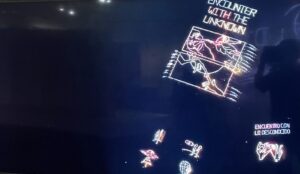
『未知との遭遇』
『Encounter with the Unknown』
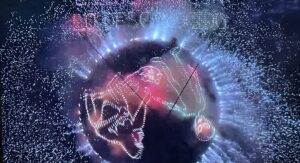
『未知との遭遇』
『Encounter with the Unknown』
Everyone must be impressed by his big and great ideas.
“Encounter with the Unknown”
“Project for Extraterrestrials”
“Project to Extend the Great Wall of China by 10,000 Meters”
Just by looking at the titles, everyone must get interested in what kind of project it is.
Extend the Great Wall of China by 10,000 meters!?
It amazes me that he came up with such grandiose idea.
It can be said that Cai Guo-Qiang is an artist with a cosmic perspective.
The point of contact between the author and Mr. Cai Guo-Qiang in New York
Now, let’s get a little personal here.
It was June 29, 1999, when I first met Mr. Cai Guo-Qiang.
The location was his office in SOHO, New York.
I was looking for a project for the 2005 Expo Aichi, Japan, and when I went to New York, an art planner recommended and introduced him to me, so I went to see Mr. Cai Guo-Qiang. His wife was also there.
“The Century with Mushroom Clouds: Project for the 20th Century”
When the art planner showed me a collection of Cai Guo-Qiang’s works for the first time, I felt something special about the photographs with surreal taste titled “The Century with Mushroom Clouds: Project for the 20th Century.”
The artist is holding something like a fire tube, from which a white cloud of smoke rises two to three meters upwards.
It was actually a representation of the atomic bomb mushroom cloud.
The exhibition catalog for this exhibition includes the artist’s own writing, “An Explosion of Converged Energy – and Gratitude” , which includes the following:
*
…I applied to enter the Nevada Nuclear Test Site, where I then held in my hand a small tube containing gunpowder extracted from firecrackers, exploding a small “mushroom cloud.” It is both a tribute to the 20th century, aka the “American Century,” and a questioning of whether the iconic visual symbol of the 20th century is contemporary art, or, in fact, a colossal mushroom cloud.
Such provocative questioning was what I did first upon arriving in the United States, and constituted my debut. The artwork conveyed a sense of crisis in human civilization symbolized by nuclear power, and echoed the concept of my earlier Projects for Extraterrestrials: humanity’s longing to venture into space, to search for superior extraterrestrial civilizations, and to help overcome the challenges of humankind.
*
At that time, there was no such a detailed explanation about the photos, but when I saw the photos, I had an intuition that he must be a suitable artist for the World Expo, a major event in human history.
Therefore, I decided to consult with Mr. Cai Guo-Qiang about the planning of the World Expo.
Since he used to live in Japan and can speak Japanese, I asked him about various things in Japanese.
When one says he is an artist, one tends to assume that he is a difficult person, but when I met him in person, he was very friendly and not arrogant at all.
It was already 24 years ago, so I don’t remember the specifics of the story, but I remember that I felt I succeeded in getting him interested in Expo 2005.
By the way, when I searched Banbapku-tei (my house), I found a few photographs of Mr. Cai Guo-Qiang and me sitting both cross-legged on the wooden floor of the empty white-walled office in New York at the time. .
I can’t introduce them here without his permission, but they are the photos with good memories and nostalgy.
Planning for Expo 2005 Aichi, Japan
By the way, some of you may be wondering why you would want to use a Chinese artist at the Expo 2005 to be held in Japan.
However, the World Expo is an international event in the first place.
Foreigners can also play important roles in World Expos.
For example, the 1876 Philadelphia World’s Fair. It was not an American composer, but the German Richard Wagner (1813-1883) who composed the “American Centennial March” for the opening ceremony of the very national event of the 100th anniversary of American independence.
They commissioned a German person to celebrate the 100th anniversary of American independence.
In fact, the “Koinoike – Night Event” sponsored by the Japan Expo Association held every night at the 2005 Aichi Expo was directed by an American, Robert Wilson (1941- ), and many team members who participated were foreign nationals.
In this way, it is not uncommon for foreign nationals to play the official role of an Expo, and Mr. Cai Guo-Qiang lived in Japan for a long time and established himself as an artist in Japan.
Cai Guo-Qiang’s own essay included in the exhibition catalog includes the following:
*
In September 1995, I received a grant from the Asian Cultural Council (ACC) for the Japan-US Exchange Program and moved to New York.
*
In terms of the spirit of the Expo, it would be desirable to have artists who have a close relationship with Japan play an important role in Expo. We thought as such.
The second time I met Mr. Cai Guo-Qiang was in Tokyo.
Time passed and it was January 6, 2003.
A planning meeting was held in Tokyo in conjunction with Mr. Cai Guo-Qiang’s visit to Japan.
This time, we specifically asked him to give us some ideas for the opening event of Expo.
Then, on February 7th, I took him to the planned site for the Expo in Aichi Prefecture and conducted an on-site inspection.
It is also a good memory that we were able to talk about various things while walking together in the “Kaisho no Mori”, which was part of the planned site.
At that time, we were given two great proposals from the artist.
Unfortunately, due to various circumstances, they were not realized at Expo 2005.
On September 25, 2005, Expo 2005 Aichi ended with a big success.
2008 Beijing Olympics Opening Ceremony
Time passed, and the 2008 Beijing Olympics was held as the next major international event after Expo 2005.
When I was watching the opening ceremony on TV at home, I instinctively leaned out of my chair with “Huh!?”
“The Beijing National Stadium”, known as “Bird’s Nest” in Beijing, was the venue for the opening ceremony.
This uniquely designed building was designed by the Swiss architectural unit Herzog & de Meuron after an international competition.
The size is 330m x 220m and the height is 69.2m.
The opening event was held in this huge stadium.
Bigfoot’s Footprints
When the countdown ended and the opening event started, fireworks were launched all at once from the top of the “Bird’s Nest”.
After that, from a little distance away, things like footprints of a giant were formed in the night sky one by one, and it was as if a giant were walking in the sky and coming to the stadium.
In fact, this was exactly one of the proposals Mr. Cai Guo-Qiang proposed for the Expo 2005.
At that time, we received this proposal and thought that it was a very suitable idea for the Expo 2005, the event of the century, and we really wanted to realize it!
Regrettably, as mentioned above, this was not possible due to various reasons.
However, three years later, at the Beijing Olympics, Mr. Cai Guo-Qiang made it happen.
I’ve only seen it on TV, but this production was truly wonderful.
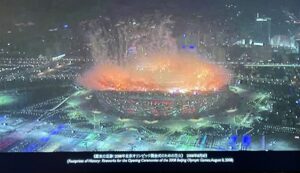
『歴史の足跡:2008年北京オリンピック開会式のための花火』2008年8月8日
『Footprints of History: Fireworks for the Opening Ceremonies of the 2008 Beijing Olympic Games』August 8, 2008
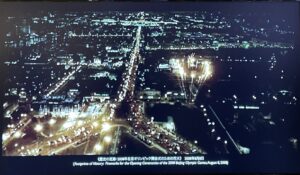
『歴史の足跡:2008年北京オリンピック開会式のための花火』2008年8月8日
『Footprints of History: Fireworks for the Opening Ceremonies of the 2008 Beijing Olympic Games』August 8, 2008
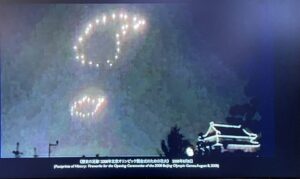
『歴史の足跡:2008年北京オリンピック開会式のための花火』2008年8月8日
『Footprints of History: Fireworks for the Opening Ceremonies of the 2008 Beijing Olympic Games』August 8, 2008
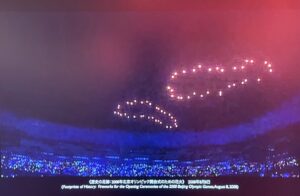
『歴史の足跡:2008年北京オリンピック開会式のための花火』2008年8月8日
『Footprints of History: Fireworks for the Opening Ceremonies of the 2008 Beijing Olympic Games』August 8, 2008
He writes in the exhibition catalog as follows;
*
Even more internationally renowned is my Footprints of History at the opening ceremony of the 2008 Beijing Olympics. The series of footprint fireworks, first conceptualized during my Primeval Fireball era as extraterrestrials crossing national borders, was finally realized in an adjusted narrative of a giant walking across the sky,…”
*
Looking at this exhibition, we can find that this idea already existed and was conceived at the time of the 1991 “Primitive Fireball” exhibition as《Bigfoot’s Footprints: Project for Extraterrestrials No.6》.
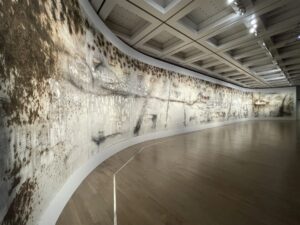
『歴史の足跡』のためのドローイング
Drawing for 『Footprints of History』
Conceived in 1991 and realized in 2008.
It’s also a big project in terms of time.
It was a pity that we could not realize it in Expo 2005, but I was fortunate to see in real time that a long-standing concept was finally realized at the Olympics, which attracted the attention of the world.
By the way, when I was watching it on TV, the “footprints” were so beautifully made, even though they were in the city, that I had the suspicion that they synthesized them in some way using CG, etc. in the production on TV.
However, at this exhibition, when I checked the video “E Historical Footprints: Fireworks for the 2008 Beijing Olympics Opening Ceremony”, it turned out that it was actually launched from a special launch pad about the size of a tank from the ground.
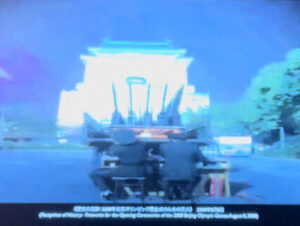
『歴史の足跡:2008年北京オリンピック開会式のための花火』2008年8月8日 より 花火の発射台
『Footprints of History: Fireworks for the Opening Ceremonies of the 2008 Beijing Olympic Games』August 8, 2008
Fireworks Launcher
This must have been a very difficult project, with many launch pads built, repeated rehearsals, and a detailed plan of where to shoot the images.
By the way, about another idea that Mr. Cai Guo-Qiang proposed for “Expo 2005”, I won’t go into that here, as he may implement it at some occasion in the future.
I’m really looking forward to seeing Mr. Cai Guo-Qiang’s future projects.
